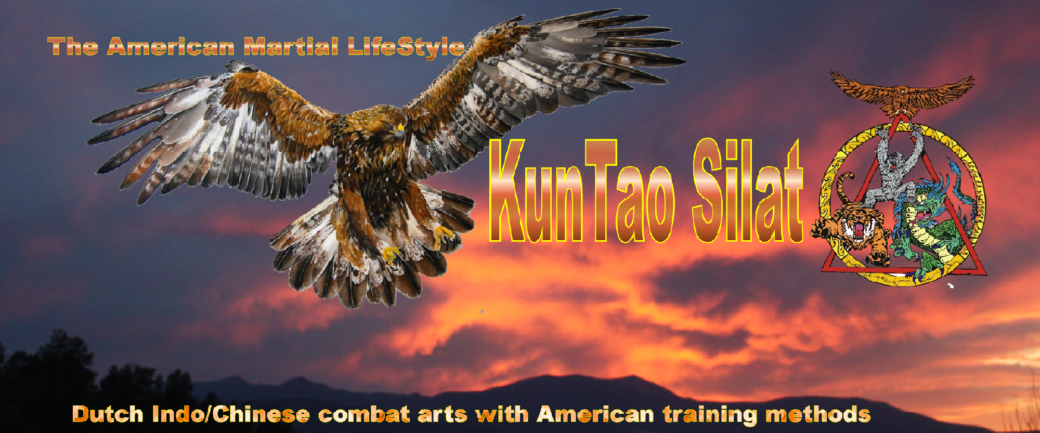
Pak Steve delivers a painful primer on Gunting for Ibu Rose and Ibu Julie.
“Good!” Pak Steve expressed his approval as I managed to keep my footing in the dry creek bed while we played Sticky Hands. “But now we add Gunting!” Next thing I knew my wrist was caught in a painful hold. I escaped only to have the flesh on my inner bicep snatched. Then the fingers on either arm were seized, opening me up for an elbow to the chin. Playing with Pak Steve was like sticking my arms into a garbage disposal.
Pak Steve is good at Gunting.
But what is Gunting? I first heard the term used in Filipino Martial Arts, where it is translated as “scissors,” and refers to techniques used to disable an opponent’s attacking limb. Indonesian arts also make use of this principle and can utilize this same term. Gunting is the spice added on top of the essential ingredients of good stance work, advantageous angling, proper timing, and lethal precision to give you that extra edge over an enemy.
In KunTao Silat, we use “Gunting” as a catch-all term for maiming techniques that use pain and/or damage to the soft tissue, nerves, bones, and joints to discourage and disable our enemy. Pak Steve compared Gunting to old “Catch-as-Catch Can” Wrestling. In this way it is inclusive of “Chin Na” as seen in classical Chinese systems or “Kuncian” in pure Silat arts, although semantics can be nuanced from system to system.
The major categories of Gunting are:
- Joint Locks/Breakers: Targeting the structural integrity of tendons, ligaments, and bones. It is important to remember that KunTao Silat does not emphasizing joint locks as “submissions” but as means to maim and disable an enemy, hence our frequent use of the term, “breaker,” as we apply the movement with sufficient speed, force, and intent to produce injury before the opponent can register enough pain to submit (or have an opportunity to counter/escape). The major breakers first taught usually involve the enemy’s outstretched arm being barred across our horse stance or abdomen as he falls, making use of gravity for power and leverage. However, KunTao Silat does have the wrist twists and small joint manipulation seen in Jūjutsu and Chin Na; but these techniques can be more difficult for novice martial artists to learn and since a civilian’s job is to escape danger and not try to restrain or control an attacker we typically reserve their practice until after a practitioner has inculcated the major entries, counters, and hitters into his or her automatic reflexes. With sufficient skill and confidence, locks provide us a “scale of force” for the proverbial “drunk uncle” who may not warrant permanent anatomical re-arrangement.
- Flesh Attacks: Pinching and clawing motions that can produce anything from a wasp sting like jolt to the tearing of flesh and removal of tissue. The various animals each have their own “flavor” of flesh attacks, although the Tiger is perhaps the most obvious. Flesh attacks provide an extra bit of leverage and control when manipulating the enemy’s body into a favorable position to throw, takedown, or strike.
- Vital Point Attacks: For us, this includes both the, “Dian Mai/Dim Mak,” or attacks against meridians and vessels and, “Dian Xue,” or attacks against the acupuncture points. The hard surfaces of our body are used to pinpoint vulnerable targets on important structures such as blood vessels, nerves, bones, and tendons. This can produce anything from a painful recoil to a vasovagal faint (or worse) and can be extremely dangerous. Pak Steve developed a subclavian venal thrombosis following a strike to one of these points that almost killed him had Grandmaster Bill Chang not intervened. The painful smacks and smashes involved in our basic palm waving blockers teach you this skill from the outset and build to increasing levels of sophistication. Again, each of our forms adds to the combat technology of Vital Point Attacks, but the Dragon is particularly noted for its lethal precision.
- Breath/Circulation Attacks: While strangle holds are the obvious example, blows against the diaphragm or other muscles of the torso relating to respiration can also produce a choking effect. Prolonged compression of blood vessels or nerves can lead to numbness and loss of function in the limbs or unconsciousness. Again, in KunTao Silat we do not emphasize “submission” as self-defense typically does not require the average person to “capture” their attacker, but such knowledge is appropriate for the experienced player so that he or she can develop a scale of force, as well as understand the types of techniques someone trained in the grappling arts may use against them.It does not take a lot of imagination to see how much crossover there is among the categories above, so do not feel obligated to limit oneself based upon etymology or semantics.Gunting are found in both partner drills as well as Sticky Hands. However, it is important that a player first develop their stances, balance, angling and kinesthetic alignment rather than try to “skip ahead” to Gunting in order to use pain to compensate for one of these fundamental principles. Remember: every body is different and while the bell curve tells us that most people will react to certain techniques in a predictable way, in the real world factors such as adrenaline, drugs, and variations in mentality and physiology can make a big difference!
When drilling your forms, think about the Gunting available to you in each position and from each djurus. Before long, you too will be a blender to your opponent!
Dr. Jon

Pak Steve gets a lesson in locking from Grandmaster Bill Chang.
Discover more from KunTao Silat
Subscribe to get the latest posts sent to your email.

No comments yet.